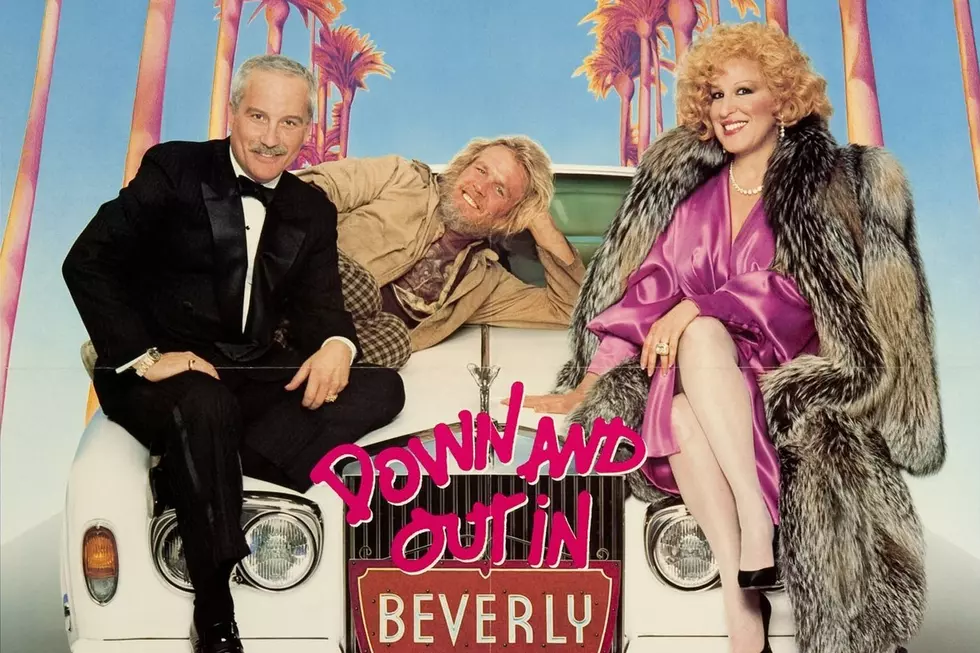
How ‘Down and Out In Beverly Hills’ Dabbled in Social Issues
Hollywood loves to make movies about how its hometown of Los Angeles is both amazing and ridiculous. There may be no better example of this than Down and Out In Beverly Hills, which premiered on January 31, 1986.
The film represents arguably the best work from the 1980s of director Paul Mazursky, who in the '60s and '70s had made the highly-regarded movies Bob & Carol & Ted & Alice, Harry and Tonto, and An Unmarried Woman. Mazursky's films always feel slightly idiosyncratic, combining elements of comedy, drama, and if not social satire then at leas a wry eye for social foibles. Down and Out In Beverly Hills captures the essence of this feeling, if not quite the full magic of his earlier work.
Watch the original trailer for 'Down and Out in Beverly Hills'
The origins of the film actually lie across the Atlantic in France, with a 1919 stage play called Boudu Saved From Drowning, by Rene Fauchois. In 1932 this was made into a film of the same name by famed French filmmaker Jean Renoir, son of the painter Pierre-Auguste Renoir and director of a number of all-time classics including The Rules of the Game and Grand Illusion.
A long-time resident of Hollywood – he got his start with an acting part in Stanley Kubrick's first movie, Fear and Desire in 1953 – and film buff, Mazursky got the idea of relocating the Renoir film to Los Angeles, and wrote the screenplay himself.
The trailer for Renoir's Boudu Saved From Drowning
At the center of the story is Dave Whiteman (Richard Dreyfuss) a businessman who lives in Beverly Hills and has made his fortune selling clothes hangers. Dave's riding high (he's just bought his first Rolls Royce) but in most ways his life is a wreck. His marriage to his wife Barbara (Bette Midler) has turned barren and sexless, his daughter Jenny (Tracy Nelson) is anorexic, and his son Max (Evan Richards) is discovering a new, androgynous self but has no way to communicate with his parents other than the avant-garde videos he makes, full of shrieking faces and exploding bombs. To top it off, Dave is sleeping with the maid Carmen (Elizabeth Pena).
This barely-functional social world is disrupted by the appearance of Jerry Baskin (Nick Nolte), a homeless man with problems of his own. The disappearance of his most faithful companion, a dog, has driven him to suicide. He wanders into the Whiteman's back yard, fills his pockets with stones from their flower planters and leaps into their pool to drown himself. When Dave drags him out of the pool and then revives him with mouth-to-mouth, a relationship between the two men begins. Dave finds that Jerry, although abrasive at times, is articulate and funny. He was once a Hollywood writer, before he was thrown over by his girlfriend, had career difficulties and decided that the most he could expect out of his life was to be able to survive on the street.
Watch a scene from 'Down and Out in Beverly Hills' (featuring a cameo by Little Richard)
For his part, Jerry discovers that his lack of expectation and pretension gives him a great deal to offer the Whitemans. Not caring at all about the idea of professional success allows him to help Dave remember there is more to life than just money, and his habit of seeing all human beings on an equal plane allows him to council Max, suggesting that he should embrace his new self rather than hiding it. His ministrations do come with complications though. He ends up sleeping first with Barbara, bringing back her sexual desire which she focuses on Dave, and then with Carmen, after which he convinces her that she should investigate radical leftist politics in order to re-evaluate her position in the class system. When Jenny comes back from college, Jerry sleeps with her as well, awakening in her the possibility of true love.
All of this comes out at the end of the film, in the course of a party that Dave's throwing for a group of Chinese clients of his hanger business. When Dave finds out that Jerry has slept with his daughter, he chases him into the swimming pool and tries to drown him; the other family members and guests jump in as well, some of them trying to break up the fight and others because they think it's a Beverly Hills tradition.
Watch Nick Nolte and Better Midler in 'Down and Out in Beverly Hills'
The film ends the next day, with the family members discovering that most of the stories Jerry has told them about his past are lies designed to make them feel good, and Jerry deciding to leave because of all the trouble he's created. He makes it as far as the alley, where the beseeching looks of the Whiteman family that has followed him convince him that maybe the life of the loner isn't for him after all. He decides to rejoin them for that drink that was a staple of '80s Hollywood and still a mystery to most of the rest of the country: a cappuccino.
While Renoir's 1932 film verged on being a scathing class satire, Mazursky's version takes away the edginess of the original and adds several dollops of Hollywood self-congratulation. This arises not just from the events of the movie, but from his casting choices.
Dreyfuss, in the wake of his Academy Award for Best Actor in The Goodbye Girl in 1977 (he was then the youngest actor to ever win the award), had developed a strong case of being star-struck with himself, resulting in a hard-partying lifestyle that ended in 1982 when, high on cocaine, he flipped his car over in Beverly Hills and had to be extracted by firefighters. The scandal did some damage to his career, and Down and Out In Beverly Hills was to serve as an announcement to Hollywood and the film-going public that he was back.
Middler had built a strong career in the '70s as a theater actor and then singer, winning a Grammy for her debut album The Divine Miss M, and then going on to sing and act on Broadway and release further albums. Her appearance in Mazursky's film was a signal to Hollywood that she was moving in their direction, and she would indeed go on to make a number of hit movies in the '80s and '90s.
Midler Singing "Boogie Woogie Bugle Boy" from 1973
For Nolte's part, he had gotten his start as a repertory theater actor and then model, before moving on to feature in mostly tough-guy roles in his early films. Down and Out In Beverly Hills was his chance to prove that he could help carry a film with a more directly comedic roll.
All of it combines for a quintessential Hollywood morality tale. Jerry's homelessness is treated more or less seriously, but seems to be solved in the end by the good-hearted wealthy people who take him in. If only the issue of homelessness writ large could be taken care of in this way!
From the other side, all of the familial problems the film touches on – from marital infidelity to eating disorders to gender uncertainty – are solved by the homey advice of a wise hobo. It's not, that is to say, a searing indictment of much of anything. Instead, it's a feel-good comedy which reassures us that if we try to be good to each other, things will work out in the end. A touch vapid, perhaps, but delightful just the same.
The Best Rock Movie From Every Year: 1955-2020
More From 96.5 KVKI








![COVID Restrictions Eased in NOLA, Bourbon St Packed [VIDEO]](http://townsquare.media/site/33/files/2021/02/GettyImages-96760210.jpg?w=980&q=75)

